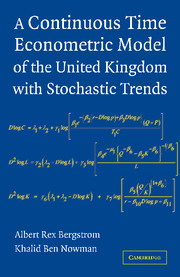Book contents
- Frontmatter
- Contents
- List of Figures and Tables
- Foreword by Peter C. B. Phillips
- Preface
- 1 Introduction to Continuous Time Modelling
- 2 Continuous Time Econometrics with Stochastic Trends
- 3 Model Specification
- 4 Steady State and Stability Analysis
- 5 Empirical Estimation of the Model and Derived Results
- References
- Author Index
- Subject Index
4 - Steady State and Stability Analysis
Published online by Cambridge University Press: 03 March 2010
- Frontmatter
- Contents
- List of Figures and Tables
- Foreword by Peter C. B. Phillips
- Preface
- 1 Introduction to Continuous Time Modelling
- 2 Continuous Time Econometrics with Stochastic Trends
- 3 Model Specification
- 4 Steady State and Stability Analysis
- 5 Empirical Estimation of the Model and Derived Results
- References
- Author Index
- Subject Index
Summary
Introduction
An important feature of the continuous time macroeconometric model specified in this monograph is that, like the model of Bergstrom and Wymer [1976] and the many models for which that model has served as a prototype, it is designed in such a way as to permit a rigorous mathematical analysis of its steady state and stability properties, thus providing an important check on its capacity to generate plausible long-run behaviour. Such a steady state and stability analysis is carried out in this chapter. In Section 4.2, we show that, when the exogenous variables satisfy certain conditions and the stochastic innovations have their expected value zero, the model has a steady state solution in which all variables grow at constant exponential rates (in some cases zero). Closed formulae from which the exact steady state paths of the variables can be computed are derived in Appendix A. In Section 4.3 and Appendix 4.3, we derive, from the original model, an explicit differential equation system in the logarithms of the ratios of the variables to their steady state paths and show that the nonlinear part of this system satisfies the Poincaré–Liapounov–Perron conditions (see Bellman [1953, p. 93] and Coddington and Levinson [1955, p. 314]). The latter conditions ensure that the asymptotic stability of the steady state solution derived in Section 4.2 depends on the eigenvalues of the linear part of this system; that is it depends on the eigenvalues of the matrix of coefficients of the linear part of this system when it is written in the form of a first-order system of higher dimension.
- Type
- Chapter
- Information
- Publisher: Cambridge University PressPrint publication year: 2007



